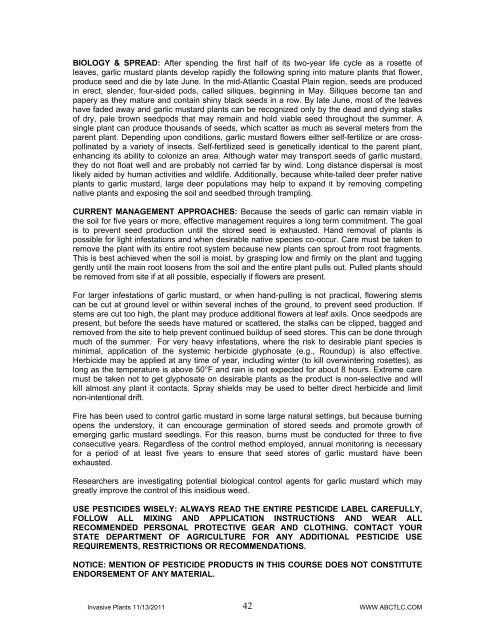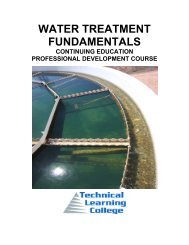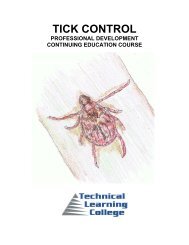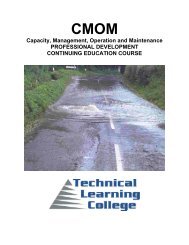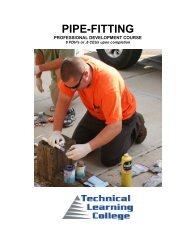INVASIVE PLANTS - Technical Learning College
INVASIVE PLANTS - Technical Learning College
INVASIVE PLANTS - Technical Learning College
You also want an ePaper? Increase the reach of your titles
YUMPU automatically turns print PDFs into web optimized ePapers that Google loves.
BIOLOGY & SPREAD: After spending the first half of its two-year life cycle as a rosette of<br />
leaves, garlic mustard plants develop rapidly the following spring into mature plants that flower,<br />
produce seed and die by late June. In the mid-Atlantic Coastal Plain region, seeds are produced<br />
in erect, slender, four-sided pods, called siliques, beginning in May. Siliques become tan and<br />
papery as they mature and contain shiny black seeds in a row. By late June, most of the leaves<br />
have faded away and garlic mustard plants can be recognized only by the dead and dying stalks<br />
of dry, pale brown seedpods that may remain and hold viable seed throughout the summer. A<br />
single plant can produce thousands of seeds, which scatter as much as several meters from the<br />
parent plant. Depending upon conditions, garlic mustard flowers either self-fertilize or are crosspollinated<br />
by a variety of insects. Self-fertilized seed is genetically identical to the parent plant,<br />
enhancing its ability to colonize an area. Although water may transport seeds of garlic mustard,<br />
they do not float well and are probably not carried far by wind. Long distance dispersal is most<br />
likely aided by human activities and wildlife. Additionally, because white-tailed deer prefer native<br />
plants to garlic mustard, large deer populations may help to expand it by removing competing<br />
native plants and exposing the soil and seedbed through trampling.<br />
CURRENT MANAGEMENT APPROACHES: Because the seeds of garlic can remain viable in<br />
the soil for five years or more, effective management requires a long term commitment. The goal<br />
is to prevent seed production until the stored seed is exhausted. Hand removal of plants is<br />
possible for light infestations and when desirable native species co-occur. Care must be taken to<br />
remove the plant with its entire root system because new plants can sprout from root fragments.<br />
This is best achieved when the soil is moist, by grasping low and firmly on the plant and tugging<br />
gently until the main root loosens from the soil and the entire plant pulls out. Pulled plants should<br />
be removed from site if at all possible, especially if flowers are present.<br />
For larger infestations of garlic mustard, or when hand-pulling is not practical, flowering stems<br />
can be cut at ground level or within several inches of the ground, to prevent seed production. If<br />
stems are cut too high, the plant may produce additional flowers at leaf axils. Once seedpods are<br />
present, but before the seeds have matured or scattered, the stalks can be clipped, bagged and<br />
removed from the site to help prevent continued buildup of seed stores. This can be done through<br />
much of the summer. For very heavy infestations, where the risk to desirable plant species is<br />
minimal, application of the systemic herbicide glyphosate (e.g., Roundup) is also effective.<br />
Herbicide may be applied at any time of year, including winter (to kill overwintering rosettes), as<br />
long as the temperature is above 50°F and rain is not expected for about 8 hours. Extreme care<br />
must be taken not to get glyphosate on desirable plants as the product is non-selective and will<br />
kill almost any plant it contacts. Spray shields may be used to better direct herbicide and limit<br />
non-intentional drift.<br />
Fire has been used to control garlic mustard in some large natural settings, but because burning<br />
opens the understory, it can encourage germination of stored seeds and promote growth of<br />
emerging garlic mustard seedlings. For this reason, burns must be conducted for three to five<br />
consecutive years. Regardless of the control method employed, annual monitoring is necessary<br />
for a period of at least five years to ensure that seed stores of garlic mustard have been<br />
exhausted.<br />
Researchers are investigating potential biological control agents for garlic mustard which may<br />
greatly improve the control of this insidious weed.<br />
USE PESTICIDES WISELY: ALWAYS READ THE ENTIRE PESTICIDE LABEL CAREFULLY,<br />
FOLLOW ALL MIXING AND APPLICATION INSTRUCTIONS AND WEAR ALL<br />
RECOMMENDED PERSONAL PROTECTIVE GEAR AND CLOTHING. CONTACT YOUR<br />
STATE DEPARTMENT OF AGRICULTURE FOR ANY ADDITIONAL PESTICIDE USE<br />
REQUIREMENTS, RESTRICTIONS OR RECOMMENDATIONS.<br />
NOTICE: MENTION OF PESTICIDE PRODUCTS IN THIS COURSE DOES NOT CONSTITUTE<br />
ENDORSEMENT OF ANY MATERIAL.<br />
Invasive Plants 11/13/2011 42<br />
WWW.ABCTLC.COM


